When I first picked up a small backup power bank, I assumed it would be as simple as “plug and play.” But I quickly discovered that, like many gadgets, the difference between a tool that works flawlessly and one that disappoints lies in small habits and smart usage.
In this complete guide, I’ll share my personal experiences, common mistakes to avoid, and practical tips to keep your electronics running smoothly wherever life takes you. Whether you’re traveling, commuting, or just need a reliable way to top up your devices, this article covers everything you need to know about using a power bank correctly and safely.
What You’ll Learn
By the end of this guide, you’ll understand:
- How portable power banks actually work
- The different types and when to use them
- Pre-use checks to prevent frustration
- Step-by-step instructions for safe, efficient charging
- Tips to extend battery life and performance
- Essential safety measures
- Troubleshooting techniques for common issues
- Real-world uses beyond smartphones
- Travel and eco-friendly charging advice
- Answers to the most frequently asked questions
At its core, a portable charger (often called a power bank) is a compact energy storage device that allows you to provide power to electronics without relying on wall outlets.
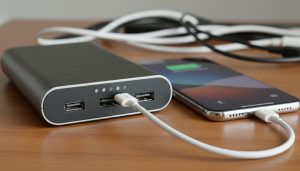
What Is a Power Bank Charger?
At its core, a portable power bank is a compact energy storage device that lets you charge electronic gadgets without relying on a wall outlet. Inside, it houses rechargeable lithium-ion or lithium-polymer cells the same technology found in smartphones and laptops optimized for storing and releasing energy efficiently.
These pocket-sized units are incredibly convenient. Whether you’re on a long flight, hiking in the wilderness, or just stuck in traffic, a power bank keeps your devices alive when outlets aren’t available.
Understanding Portable Power Units
A modern power bank has several key parts:
- Input ports: For recharging the power bank itself, usually via USB-C or Micro-USB.
- Output ports: Where you connect your devices to draw power.
- Indicators: LED lights or digital displays showing remaining battery capacity.
- Control buttons: Some models need to be manually activated; others start charging automatically when you plug in a device.
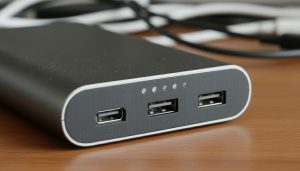
These devices are versatile, capable of powering smartphones, tablets, smartwatches, wireless earbuds, cameras, and in some cases, even laptops.
If you’re new to this, you might want to explore a beginner-friendly guide on what a power bank charger is.
Different Types of Power Banks and Their Uses
Over the years, I’ve tried nearly every type available. Each serves a unique purpose:
Compact Everyday Power Bank Units
These are lightweight, affordable, and perfect for topping up a smartphone once or twice a day. Ideal for commutes or casual outings.
High Capacity Models
Larger in size but capable of multiple full charges. Many include USB-C Power Delivery (PD), allowing them to charge tablets or laptops.
Slim Pocket Power Bank Versions
Extremely portable and sleek easy to slip into a jacket or small bag. However, their limited capacity makes them best suited for quick top-ups.
Solar Powered Power Banks
Perfect for camping or hiking trips. They rely on sunlight for charging, so they’re eco-friendly but slower and weather-dependent.
Wireless Charging Models
For compatible phones, these eliminate cables altogether. They offer convenience, though wired charging is still faster.
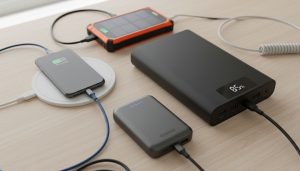
For a detailed explanation, you can also check this: https://pickerzen.com/how-to-use-a-power-bank-for-the-first-time/
Pre-Use Checklist
Before leaving home with your portable charger, take a moment to run through this quick checklist:
- Fully Charge the Power Bank – Don’t assume it’s full; most ship at 50% capacity.
- Use the Correct Cable – Mismatched cords can slow charging or stop it entirely.
- Check Battery Indicators – Ensure enough juice for your plans.
- Pack Safely – Keep away from keys, coins, or anything that might scratch or short-circuit it.
These small steps can prevent frustration and extend the life of both your charger and devices.
Step by Step Guide: How to Use a Power Bank Charger
Even though it seems simple, there’s a right way to connect and charge efficiently. Here’s the method I recommend:
Step 1: Check the Power Bank’s Charge Level
Before you start, make sure your portable power bank is adequately charged. Most power banks have LED indicators that show their current battery level. If the lights are low or not lit, charge the power bank first.
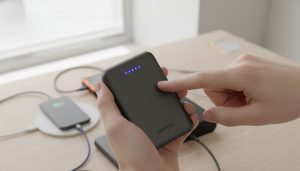
Step 2: Locate the Correct Cable
You’ll need a charging cable that is compatible with your smartphone. This is usually a USB-A to USB-C, USB-A to Lightning, or USB-C to USB-C cable, depending on your phone’s model.
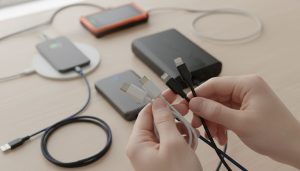
Step 3: Connect the Cable to the Power Bank
Plug the larger end of your charging cable (usually USB-A or USB-C) into the output port of the power bank. Power banks often have multiple output ports, so choose one that fits your cable.
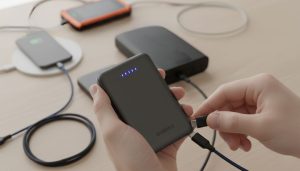
Step 4: Connect the Cable to Your Smartphone
Now, plug the other end of the charging cable into your smartphone’s charging port.
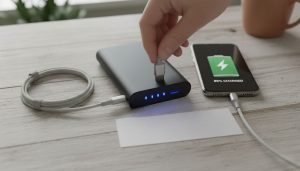
Step-by-step guide showing how to connect a phone to a fully charged portable power bank
Pro Tip: Don’t leave devices plugged in overnight. Once your phone hits 100%,
Maintaining Your Power Bank for Longevity
A well-cared-for unit can last for years. Follow these maintenance tips:
- Avoid Overcharging or Deep Draining: Most have built-in protection, but unplug when full.
- Use Quality Cables: Cheap cords can damage ports or slow charging.
- Store at Room Temperature: Extreme heat or cold harms battery cells.
- Recharge Every Few Months: Even when unused, lithium batteries lose charge slowly.
- Keep at 50% for Long-Term Storage: Ideal for preserving battery health.
If you own multiple units, rotate usage to prevent uneven wear.
Disconnect it to conserve battery health and power bank life.
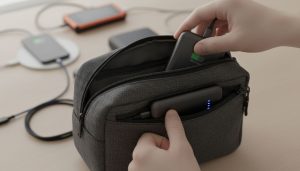
Essential Power Bank Safety Measures
Power banks hold significant energy, so handle them wisely:
- Buy from trusted brands avoid cheap, no-name models.
- Keep away from water and direct sunlight.
- Stop using it if it becomes swollen, cracked, or emits an odor.
- Follow airline rules: most carriers limit power banks to under 100Wh in carry-on luggage.
- Don’t cover it while charging it can overheat.
For further safety advice, you can read this HP portable charger guide.
Common Power Bank Mistakes to Avoid
Here are a few errors I’ve made and learned from:
- Using the wrong cable: Slows charging drastically.
- Charging both ways simultaneously: Plugging the power bank in to recharge while it’s charging another device causes overheating.
- Leaving it in a hot car: Heat damages lithium cells permanently.
- Ignoring indicator lights: They’re your best clue to battery health.
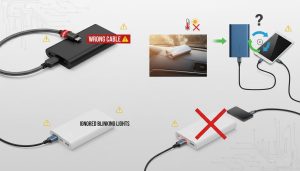
Avoiding these mistakes keeps your portable charger reliable and efficient.
Quick Fixes for Misbehaving Units
Even well-made devices occasionally act up:
- Device not charging: Swap the cable or try another port.
- Slow charging: Avoid low-output USB ports.
- Automatic shut-offs: Let the battery cool down before retrying.
- LED indicators not lighting: Clean the ports gently.
If these fixes fail, it may be time to retire the unit or consult the manufacturer.
Troubleshooting Common Power Bank Problems
Even good-quality power banks can occasionally misbehave. Try these quick fixes:
- Device not charging? Swap cables or test another port.
- Slow charging? Use a high-output port (2A or more).
- Automatic shut-offs? Let the unit cool before retrying.
- No LED indicators? Clean dust or debris from the ports gently with a soft brush.
If problems persist, your battery cells might be degraded it could be time for a replacement.
Real World Uses Beyond Phones
While most people buy power banks for smartphones, their uses extend far beyond that:
- Tablets: Great for long flights or study sessions.
- Laptops: High-capacity USB-C models can add hours of productivity.
- Smartwatches and fitness trackers: Small devices, low power drain perfect match.
- Cameras: Ideal for travel photographers or vloggers.
- Portable fans, speakers, or LED lights: Great for outdoor events or emergencies.
I’ve personally powered everything from camping lamps to mini projectors using a mid-sized power bank. Their versatility is incredible.
Travel Tips and Best Practices
Traveling with portable batteries is now almost a necessity. Here’s how to stay powered and compliant:
- Keep your power bank in carry-on luggage never in checked bags.
- Make sure it’s under 100Wh, per airline rules.
- Store it accessibly for security checks.
- Bring a multi-port charger if you travel with multiple devices.
- Rotate charging among your devices to even out wear.
- Consider solar-powered models for off-grid trips.
With these habits, you’ll never worry about a dead battery on the road again.
At airports, power outlets are often scarce or malfunctioning. Having your own energy source ensures you stay productive and connected.

Eco-Friendly and Sustainable Options
As sustainability becomes more important, eco-conscious designs are emerging:
- Recycled materials: Some brands now use eco-friendly casings.
- Solar power: Ideal for hikers and campers.
- Battery recycling programs: Reduce waste responsibly.
Choosing an environmentally friendly model helps you stay charged while reducing your carbon footprint.
The Future of Portable Charging
Technology is evolving fast. Expect exciting improvements in the coming years:
- GaN (Gallium Nitride) chargers: More compact yet more powerful.
- Wireless pads and integrated backpacks: Built-in charging while on the go.
- Smart energy management: AI-driven systems to optimize charging speed and battery health.
Soon, even wallets or keychains may double as small power sources a sign of just how embedded portable energy will become in everyday life.
Frequently Asked Questions
Q1: Can I leave my electronics plugged in overnight?
No. Once full, unplug your device to prevent unnecessary power drain.
Q2: How do I know when my power bank is full?
Check the LED lights or display solid lights usually indicate 100% charge.
Q3: Is it safe to carry a power bank on an airplane?
Yes, in carry-on luggage. Units over 100Wh may require airline approval.
Q4: Can a power bank damage my phone?
Not if you use quality products. Avoid cheap brands lacking safety certification.
Q5: How long does a power bank last?
Typically 2–3 years or around 300–500 full charge cycles, depending on use.
Final Thoughts
A portable power bank has saved me countless times during flights, road trips, power outages, and outdoor adventures. When used correctly, it’s one of the most practical accessories you can own.
By following the steps and safety tips in this guide, you’ll not only extend your power bank’s life but also ensure your devices stay powered when you need them most. Whether you’re a traveler, student, or professional, mastering how to use a power bank charger will make your daily life easier, safer, and more connected.
So the next time your phone flashes that dreaded “1%,” you’ll smile because you’ll know exactly what to do.